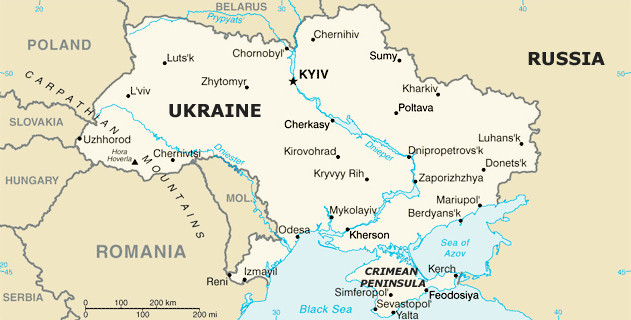The Radical Menace to Ukraine

(Bloomberg – bloomberg.com – Leonid Bershidsky – August 31, 2015)
A police officer was killed during a protest in Kiev on Monday. It was the first such fatality since Ukraine’s “Revolution of Dignity” last year. Radical nationalists, some with weapons, gathered to protest a constitutional amendment proposed by President Petro Poroshenko that would make it possible to reintegrate separatist areas into Ukraine on special terms favorable to Russia.
Although a majority in the Ukrainian parliament voted to support the measures, the street clashes show how difficult it will be to sell the changes to an impoverished, volatile country filled with weapons. President Vladimir Putin appears to be looking for a way out of the mess in eastern Ukraine, but even after more than a year of war, many Ukrainians are unwilling to end the fighting in a way that would be acceptable to Russia.
According to a Facebook post by Interior Minister Arsen Avakov, 122 people were wounded, some seriously, as protesters threw “explosive devices” — hand grenades, according to other sources — at soldiers guarding the parliament building. Avakov said one police officer was killed.
Avakov blamed Svoboda, an ultranationalist party, for the violence, as did some other eyewitnesses. Svoboda, however, said it was “a planned provocation against Ukrainian patriots,” also blaming the authorities for “provoking Ukrainians to protest.” About 30 people have been arrested. Their political affiliations probably will be made public soon. The authorities may look for a Russian connection, but they will probably only find radical Ukrainian nationalists who desire to fight the war against Russia and its proxies in eastern Ukraine to the bitter end.
In parliament, Yuri Shukhevich, a legislator with the populist Radical Party, called the proposed constitutional changes a “betrayal of Ukrainian national interests” because they give too much autonomy to the separatist areas:
They get their own police, their own courts, prosecutors, taxes, they have the right to special relationships with neighboring Russian regions. So what next, will they be allowed to open their own embassies tomorrow?
None of those powers are mentioned in Poroshenko’s amendments, which only call for separatist areas to be governed according to a special law. A similar law was passed last March that granted rather broad autonomy to the eastern Ukrainian territories around Donetsk and Luhansk. It was suspended, however, after the February cease-fire broke down. Yuri Shukhevich, son of Roman Shukhevich, a high-profile Nazi collaborator and a hero to the Ukrainian right, is worried that once the constitutional amendment is passed, the law will be reinstated to appease Putin.
He and other nationalists have some good reasons to believe that will happen. The U.S. and Europe have put pressure on Poroshenko to push through the constitutional changes. Assistant Secretary of State Victoria Nuland visited Kiev in July to try to persuade Ukrainian lawmakers to back the measures. She even met with a few recalcitrant parliamentarians. She failed: Five of the six attendees of the meeting voted against Poroshenko’s proposals. The pressure didn’t subside, however: the vote may have been the subject of discussion in Berlin between Chancellor Angela Merkel, President Francois Hollande of France and Poroshenko on Aug. 24.
“Europe is selling us out and giving us up as it did Czechoslovakia in 1939,” Shukhevich said Monday. “This is a humiliation of the national dignity of the Ukrainian nation.”
Merkel, Hollande and U.S. officials don’t see things that way. They are busy trying to provide Putin with an honorable way to back down and aren’t particularly concerned about giving the rebels a few more powers as long as the secessionist regions reintegrate Ukraine. It is far from certain that this approach will work: the separatists have disparaged Poroshenko’s proposal as insufficient and discussed holding elections in October under their own rules, not Ukrainian ones. If they do, reintegration will fail, the half-frozen conflict will drag on and Russia may face new Western more Western sanctions.
So far, Putin appears willing to play along with Merkel and Hollande. On Aug. 29, he spoke with them by phone, agreeing to a “total cease-fire” starting Sept. 1. The day after the call, fighting in eastern Ukraine dropped off sharply after weeks of heating up. On Monday, the Ukrainian Defense Ministry reported only a few random shots fired here and there.
Given Russia’s precarious economic situation because of low oil prices, Putin may be more inclined to compromise. He would get to keep Crimea, after all. Poroshenko probably understands this well enough, without the prodding from Berlin, Paris and Washington. But he doesn’t yet have the 300 votes needed for the final approval of the constitutional changes, scheduled for December. On Monday, preliminary approval was given by 265 votes, with three parties that are members of the ruling coalition voting against it.
With local elections in the fall, populist radicalism is a major danger to Poroshenko and Prime Minister Arseniy Yatsenyuk, especially because they have failed to fulfill promises to revive the economy and their attempts to break the hold of oligarchs have been indecisive. The popularity of Yatsenyuk’s party has sunk almost to zero, and he’s joining forces with Poroshenko to avoid electoral defeat. The president remains relatively popular, but accusations that he is appeasing Putin may hurt his party’s performance.
Normalization is still a long way off for Ukraine. The bloody clashes Monday are evidence that violence is much more likely to erupt. The majority of Ukrainians may want an end to fighting, but a relatively small, angry and well-armed contingent does not. That may be just how Putin wants it.
Article ©2015 Bloomberg L.P. All Rights Reserved. Article also appeared at bloombergview.com/articles/2015-08-31/the-radical-menace-to-ukraine
